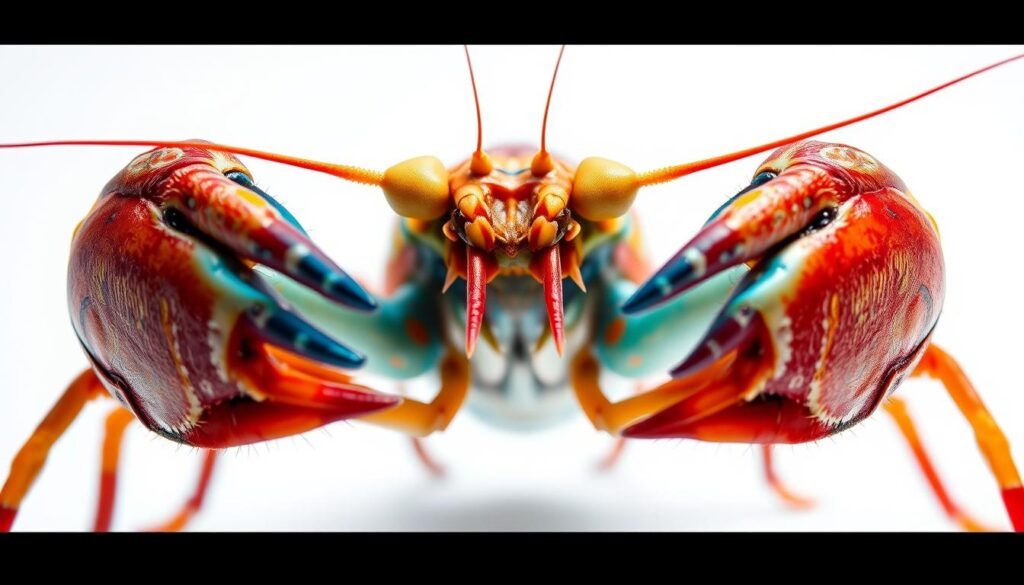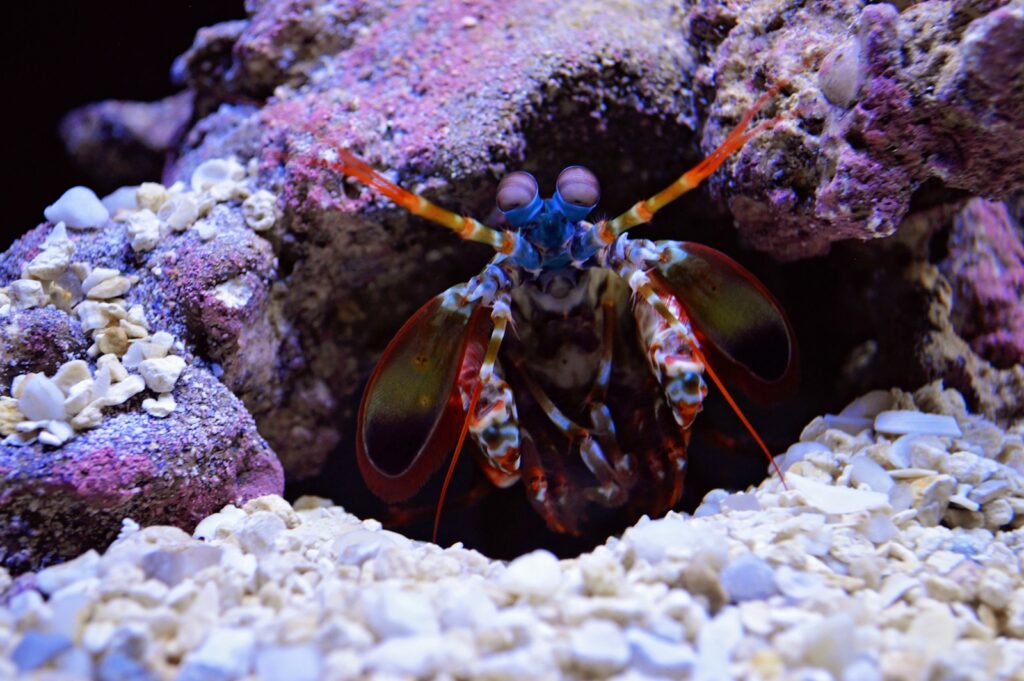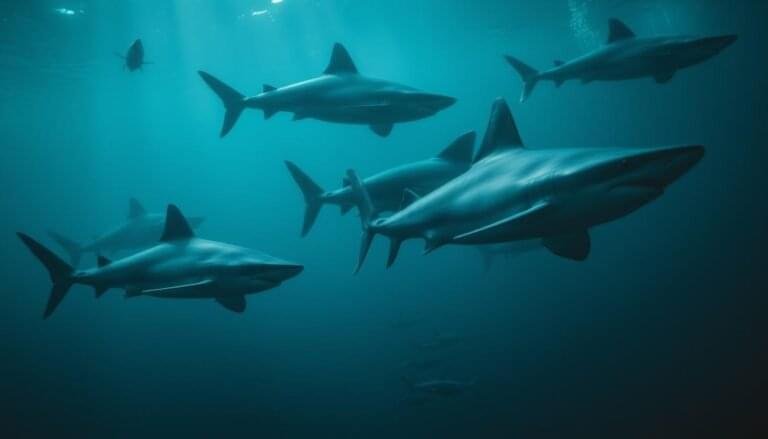Explore the fascinating world of the mantis shrimp, one of the most intriguing creatures in marine biology. Their habitat is as diverse as it is complex, ranging from vibrant coral reefs to the soft seabeds of the ocean floor.
Understanding the mantis shrimp habitat is crucial for marine enthusiasts. These small but formidable crustaceans have thrived for millions of years, adapting to various underwater environments.
From the peacock mantis shrimp to other species, their rapid strike mechanism has captivated scientists. This guide delves into their anatomy, evolution, and the innovative research they inspire.
Key Takeaways
- Mantis shrimp inhabit diverse marine environments worldwide.
- Their habitats range from coral reefs to deep seabeds.
- Known for their rapid, powerful strikes, studied for scientific advancements.
- Research on mantis shrimp contributes to marine biology and material science.
- Understanding their habitat aids in marine conservation efforts.
Understanding the Mantis Shrimp Habitat
Mantis shrimp thrive in diverse underwater environments, showcasing remarkable adaptability. Their habitats range from vibrant coral reefs to the soft seabeds of the ocean floor. This adaptability is a testament to their resilience and evolutionary success.
Distinct Seabed and Coral Reef Environments
Coral reefs provide mantis shrimp with complex structures to hunt and hide. These crustaceans often burrow into sandy seabeds, creating intricate networks of tunnels and dens. Such burrows serve as safe havens, protecting them from predators and providing ambush points for prey.
Role of Burrows and Natural Cavities
Burrows are crucial for mantis shrimp survival. They excavate these tunnels using their powerful claws, creating shelters that shield them from threats. Natural cavities in coral reefs also offer refuge, highlighting their ability to utilize existing structures for protection.
Environmental factors like water clarity and reef complexity influence where mantis shrimp settle. Clearer waters may offer better hunting visibility, while complex reefs provide more hiding spots. These crustaceans are highly selective in choosing their homes, ensuring optimal survival conditions.
Anatomy and Physiology: A Closer Look at Mantis Shrimp

Mantis shrimp are marvels of evolutionary engineering, with bodies designed for both power and precision. Their unique adaptations make them one of the most fascinating creatures in the ocean.
Mantis Shrimp’s Powerful Claws: Spearers and Smashers
Their claws are divided into two distinct types: spearers and smashers. Spearers use a sharp, needle-like appendage to pierce soft-bodied prey, while smashers have a club-like claw that delivers devastating blows. This club can accelerate with incredible force, creating cavitation bubbles that further enhance their striking power.
These appendages are not just for hunting; they also play a role in defense and territorial disputes. The force generated by smashers is so immense that it can stun or even kill predators, making them a formidable opponent in the underwater world.
Complex Visual Systems and Multi-Wavelength Eyes
Mantis shrimp possess some of the most advanced eyes in the animal kingdom. With up to 12 photoreceptor types, they can see a wide range of wavelengths, including ultraviolet and infrared. This multi-wavelength vision allows them to detect polarized light, which helps in navigation and finding prey.
Their eyes are mounted on movable stalks, providing almost 360-degree vision. This trinocular vision enhances depth perception, crucial for accurately striking prey with their powerful claws. Such advanced visual capabilities are unmatched among other marine animals.
Scientists are inspired by these biological marvels, drawing parallels to human technology. The mantis shrimp’s eyes are often compared to high-tech cameras, offering insights into how we might develop better optical systems in the future.
Evolution and Life History of Mantis Shrimp
The evolutionary journey of mantis shrimp reveals a fascinating story of adaptability and resilience. These crustaceans have thrived for over 400 million years, originating from the Carboniferous period and evolving into the diverse species we see today.
Fossil Record and Ancient Origins
Fossil records show that mantis shrimp have remained largely unchanged for millions of years. Their ancient ancestors already displayed the distinctive claws and advanced eyes that modern species are known for. The emergence of the suborder Unipeltata marked a significant milestone in their evolution, showcasing key adaptations that enabled their survival.
Modern mantis shrimp have spread across the world’s oceans, with a strong presence in the Pacific region. Their ability to adapt to various environments has led to the development of over 520 species, each with unique characteristics tailored to their ecological niches.
Their life cycle includes complex mating rituals where both males and females play active roles in reproduction. Females carry eggs until they hatch, a behavior supported by recent scientific studies highlighting the importance of parental care in their life history.
- The evolutionary journey of mantis shrimp spans over 400 million years, originating from the Carboniferous period.
- Fossil records reveal that ancient mantis shrimp already possessed advanced features like powerful claws and complex eyes.
- The emergence of the suborder Unipeltata marked a significant evolutionary milestone.
- Modern species have adapted to various marine environments, leading to over 520 distinct species.
- Mantis shrimp exhibit complex reproductive behaviors, with both males and females contributing to egg care.
The study of mantis shrimp’s evolution not only deepens our understanding of their biology but also highlights their impact on the marine world. Their ability to thrive across different periods underscores their ecological significance and adaptability.
Hunting Strategies and Rapid Strike Mechanics
Mantis shrimp are renowned for their lightning-fast strikes, which are among the most powerful in the animal kingdom. These strikes are not just for hunting but also serve as a defense mechanism, making them formidable opponents underwater.
Spearers vs. Smashers: Unique Attack Techniques
Mantis shrimp employ two distinct hunting strategies: spearers and smashers. Spearers use sharp, needle-like appendages to pierce soft-bodied prey, while smashers utilize club-like claws to deliver devastating blows. This specialization allows them to target a wide variety of prey effectively.
Cavitation Effects and Impact Dynamics
The rapid strike of a mantis shrimp generates incredible force, reaching up to 1,500 newtons. This force creates cavitation bubbles that collapse with immense energy, further stunning or killing prey. Such advanced mechanics inspire both scientific study and technological innovation.
- Mantis shrimp strikes can accelerate at 100,000 m/s², faster than a bullet.
- Cavitation bubbles from their strikes can exert an additional 504 newtons of force.
- These crustaceans can strike prey with speeds up to 31 m/s, equivalent to 69 mph.
These remarkable abilities make mantis shrimp apex predators in their ecosystems, capable of taking down prey much larger than themselves. Their strikes are not only a testament to evolutionary adaptation but also a subject of human innovation.
Ecological Significance and Underwater Homes
Mantis shrimp are fascinating creatures, known for their remarkable ability to construct intricate underwater homes. These burrows are more than just shelters; they play a vital role in their survival and the ecosystem.
Burrow Construction and Habitat Adaptation
These crustaceans excavate complex burrows using their powerful claws. The burrows serve as safe havens, protecting them from predators and providing ambush points for hunting. The structure of these burrows varies, adapting to different environments, from soft sea floors to hard coral reefs.
The ecological significance of these burrows extends beyond individual survival. They protect eggs and offer refuge, while also influencing the surrounding environment. Observations from aquarium studies and natural habitats reveal their adaptability and resourcefulness.
| Aspect | Soft Sea Floors | Coral Reefs |
|---|---|---|
| Burrow Complexity | Less complex, shallower | More complex, deeper |
| Construction Time | Shorter duration | Longer duration |
| Predator Protection | Basic shelter | Advanced ambush points |
Environmental factors like water clarity and ocean currents significantly influence where mantis shrimp settle. Clearer waters enhance hunting visibility, while complex reefs offer more hiding spots. Their ability to adapt ensures optimal survival conditions in diverse marine environments.
Scientific Innovations Inspired by Mantis Shrimp
The extraordinary features of the mantis shrimp have sparked groundbreaking innovations in science and technology. Their unique anatomical traits have led to breakthroughs in material science and optical technology, inspiring new developments across various industries.
Bio-Inspired Materials and Protective Gear
One of the most significant innovations comes from the mantis shrimp’s club-like claws. Researchers have studied the structure of these claws to develop impact-resistant materials. These materials are now being used in experimental body armor and sports gear, offering enhanced protection without compromising flexibility. The unique arrangement of proteins in their claws has also inspired the creation of lightweight yet durable composites, which could revolutionize industries from aerospace to automotive.
Technological Applications and Future Research
The mantis shrimp’s advanced visual system has also been a focal point for innovation. Their ability to detect polarized and multi-wavelength light has led to advancements in digital camera technology. Engineers have developed cameras that can capture images in multiple wavelengths, enhancing applications in medical imaging and environmental monitoring. Additionally, the mantis shrimp’s rapid strike mechanism is being studied to improve robotic designs, particularly in underwater exploration.
Future research directions are vast, with potential applications in aerospace and consumer electronics. For instance, materials inspired by the mantis shrimp’s structure could lead to more resilient smartphones and tablets. Moreover, the findings from these studies are influencing the design of aquariums and laboratory setups, helping to create more natural environments for marine life research.
As scientists continue to explore the mantis shrimp’s remarkable biology, we can expect even more exciting innovations. Their unique features are not only advancing technology but also deepening our understanding of marine ecosystems and conservation efforts.
Conclusion
In conclusion, the mantis shrimp stands out as one of the ocean’s most extraordinary creatures, blending remarkable adaptability with evolutionary ingenuity. Their ability to thrive in diverse environments, from coral reefs to deep seabeds, underscores their ecological importance and resilience.
Their striking anatomy, including powerful claws and advanced eyes, has not only fascinated scientists but also inspired technological advancements. Research into their biology continues to unlock innovations in materials science and optics, highlighting their impact beyond the marine world.
Understanding these crustaceans’ ecological role and unique features deepens our appreciation for marine biology and the potential for technological breakthroughs. Their story is a testament to nature’s ingenuity and its endless inspiration for human innovation.
FAQ
What makes the peacock mantis shrimp unique among other crustaceans?
How do mantis shrimp use their powerful claws to kill prey?
Can mantis shrimp be kept in a home aquarium?
How do mantis shrimp protect themselves from predators?
What role do mantis shrimp play in maintaining the balance of coral reefs?
How do mantis shrimp eyes compare to human eyes?
How do mantis shrimp construct their burrows?
Are mantis shrimp considered intelligent creatures?
How long do mantis shrimp typically live?
Can mantis shrimp be harmful to humans?
| Organization Name | URL |
|---|---|
| International Union for Conservation of Nature (IUCN) | https://www.iucnredlist.org |
| Great Barrier Reef Foundation | https://www.barrierreef.org/the-reef/animals/mantis-shrimp |
| Oceana | https://oceana.org/marine-life/peacock-mantis-shrimp/ |
| Discovery of Sound in the Sea (DOSITS) | https://dosits.org/galleries/audio-gallery/marine-invertebrates/mantis-shrimp/ |
| Monterey Bay Aquarium | https://www.montereybayaquarium.org/stories/meet-the-mantis-shrimp |








